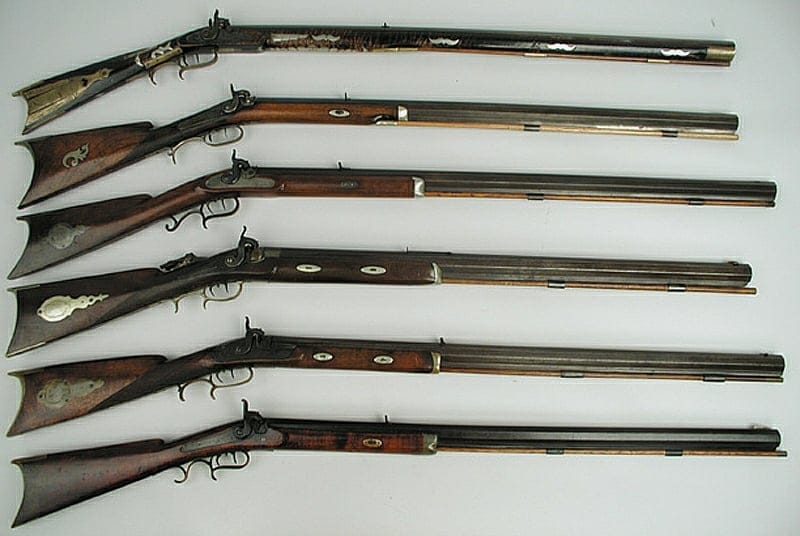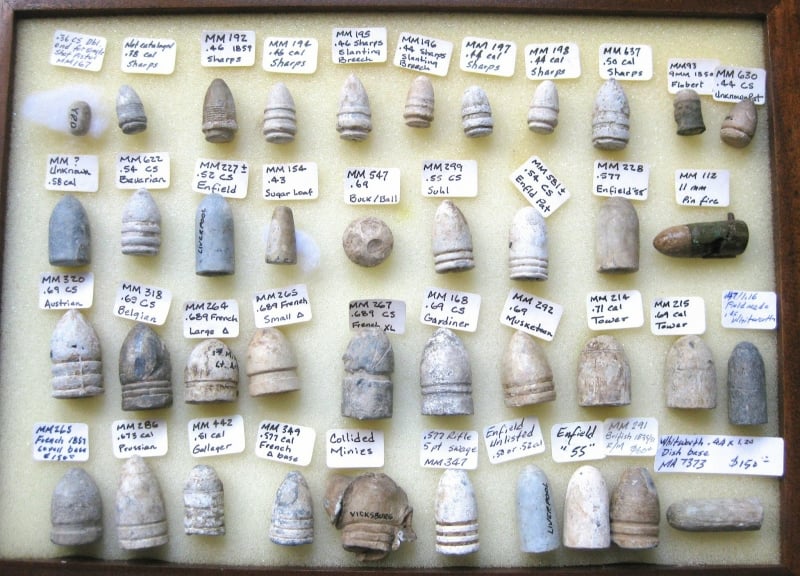Rifling is something modern shooters take for granted. We know it’s there, and so, we concern ourselves more with barrel quality and twist rates. Some folks understand rifling enough to choose certain categories, like polygonal rifling, over others, but most of us don’t care all that much. But rifling has only been a widespread thing since the 1850s. Before that, it was rare indeed. So, let’s take a brief look at rifling, what it is, and where it came from.

What is Rifling?
Simply put, rifling, in its varied forms, consists of the pattern of grooves cut into a barrel’s bore. Those grooves impart spin onto a projectile, giving it greater stability as it flies. That greater stability provides higher velocity, longer range, and better accuracy.
Think of a quarterback throwing a tightly spiraling football, as opposed to just chucking the ball end over end. The spiraling football travels further and is far more accurate. It also arrives more quickly. That’s the difference between a projectile fired through a rifled barrel, versus a projectile fired through a smoothbore barrel. In between the grooves are lands, which are the bore’s surface where there are no grooves.

Early Rifling
The first known rifled barrels emanated from two sources, both in the late 1400s. The first was Vienna gunmaker Gaspard Kollner. I don’t have a more accurate date for Kollner. The others were unnamed gunsmiths in Augsburg, Germany in 1498. It was a tedious and expensive process in which each groove was cut by hand. Some say the first rifle grooves were straight and that spiraled rifling didn’t appear for another two decades or so. I have been unable to confirm that claim, though I do question the purpose of straight grooves, given the widespread knowledge of how spin created stability.
The rifling concept wasn’t new. Archers and crossbowmen had long fletched their arrows in a helical pattern to impart spin. That spin stabilized the arrows in flight, giving them greater accuracy and range. The only new thing was applying that concept to firearms. As to the straight grooves, maybe I lack the engineering knowledge to instinctively grasp the concept. Perhaps they stabilized the projectile without spinning it. Hit me up in the comments if you know.
Some sources say the first spiraled rifling was created in 1520 by another German, Augustus Kotter of Nuremberg. The German connection is not a coincidence. German-made crossbows had long used various methods to spin their bolts, whether it be the helical fletching or shooting the bolts through a rifled tube, causing the bolts to spin. Again, the only new thing about rifling was the understandably more difficult procedure for incorporating it into firearms.
Early Rifles
Despite its late 15th-century origins, rifling did not become widespread until the 1850s. That’s because it was tedious and time-consuming, making it expensive and impractical for mass production. Large European armies needed to produce lots of guns as inexpensively as possible. Industrial capabilities didn’t catch up to the rifling concept for 350 years, meaning armies were overwhelmingly equipped with smoothbore muskets.

So, rifles were made individually, by hand, for individuals, usually for hunting. Prominent examples of these firearms are the German Jӓger (Hunter) Rifles, which influenced the American Pennsylvania and Kentucky Rifles. Some German infantry units carried their own Jӓger Rifles, including some Hessian troops in the American Revolution. American Pennsylvania and Kentucky Rifles were likewise individually owned.
The first standard British Army rifle, the Baker Rifle, appeared in 1800, during the Napoleonic Wars, and was issued to sharpshooter units. The Baker was prompted by the success of the various rifles in the American Revolution and directly patterned after Jӓger Rifles.
Musket projectiles during this time were literally round balls designed for smoothbore weapons. Rifles used similar balls, in a slightly smaller caliber than the barrel, wrapped in a greased linen patch. The patch, not the ball, engaged the rifling, imparting spin to the ball as it left the barrel.
The Minié Ball
That changed after French Army Captains Claude-Étienne Minié and Henri-Gustave Delvigne created what came to be called the Minié Ball in 1849. “Minié” is pronounced “min-YAY,” but American Civil War soldiers called the projectile the “Minnie Ball.”
The Minié Ball was a conical, soft lead projectile cut with four rings. When fired, the rings engaged the barrel’s rifling. The greased patch was no longer required, and the conical shape provided better stability and accuracy. Losing the patch increased the firing rate of infantry muskets, while providing greater performance over spinning musket balls.

On a side note, a British Army Captain named John Norton invented a similar projectile in 1832, based on blowguns he had seen in India. Norton’s design was improved by London gunsmith William Greener. But the British Army wasn’t interested. When the Brits adopted the Minié Ball in 1852, Greener sued and was paid off by the British government.
The Minié Ball’s first widespread use came in the 1853-1855 Crimean War, in which the British and French faced off against Russia. The new projectile drew immediate notice, with the London Times calling it “the king of weapons.”
The Minié Ball soon reached the United States, where it was improved once again by armorer James Burton at the Harper’s Ferry Arsenal. Burton developed a hollow projectile and a rifle to fire it. Both were adopted by the US Army. Burton’s projectile (still called a “Minié Ball”) was produced for the .58 caliber Harper’s Ferry rifled musket and the .69 caliber Springfield rifled musket. Both saw wide use by both sides in the American Civil War, contributing to the carnage as the battlefield advantage moved to the defensive side, while tactics lagged behind, as they usually do. Minié Balls came in many variations on the main theme, and Burton’s design was far from the only one used in the war.
One major battlefield change was that Minié Ball compatible rifles, being standard issue, meant that artillery could no longer set up just outside musket range and pound infantry formations with grapeshot and canister. Regular infantrymen could now decimate the artillery crews in short order. Grapeshot was mostly gone by the Civil War, but canister became a strictly defensive weapon, used against charging infantry, thanks to the new rifled muskets.
Improved Manufacturing Capabilities
The Minié Ball coincided with the Industrial Revolution, making it possible to economically mass produce rifles for entire armies. But technology soon outpaced the Minié Ball’s usefulness even before the Civil War ended. New rifled firearms like the Prussian breechloading Dreyse Needle Gun and the repeating Henry rifle and Spencer Carbine, made the Minié Ball, and muskets themselves, obsolete by the mid-to-late 1860s.
Mass production meant standardization and easier, faster rifling techniques. No longer did individual rifles require long hours of work by skilled craftsmen. Rifles became the norm, as opposed to being limited to special sharpshooter units. The American Civil War was the last major conflict in which smoothbore muskets saw widespread use.
The Civil War was the first modern war in many ways. One of those was its use of rifled cannon. Most Civil War artillery was smoothbore, but the Parrot and Whitworth rifled cannons pointed toward the future with their greater range and accuracy.

Continued Evolution
Rifled barrels have been the standard for long guns (other than shotguns) and pistols since the 1860s. Modern innovations like cold hammer forging and polygonal rifling continue to bring precision and barrel durability to the firearms industry.
Gunmakers are still developing new methods for making rifled barrels, such as 5R rifling, which creates smoother transitions from the top of the land to the bottom of the groove. It also alternates the pattern so that two lands are never directly across from one another.
Another new technique is electromagnetic machining (ECM), which uses copper combined with salt water to remove barrel material for the grooves. It’s described as the inverse of electroplating and is relatively inexpensive thus far, making it popular with do-it-yourself gunmakers. ECM is still new and not yet ready for mass production, but that development could make it even more affordable.
Rifling is a relatively new force in firearms manufacturing. Remember, the first recorded use of a firearm was in 1364, though primitive artillery predated that by several decades. Rifled barrels weren’t invented for another 134 years, and it took 350 years from that date for rifling to become widespread. That was only 160-odd years ago. As technology expands by leaps and bounds, where will it go next? Precision laser-cut grooves, maybe? I don’t know, but it seems that accuracy will only get better moving forward.


